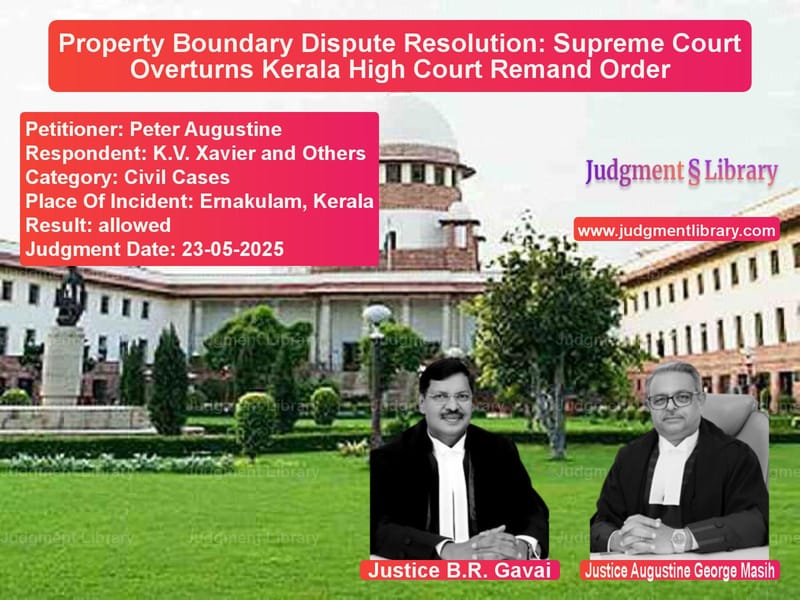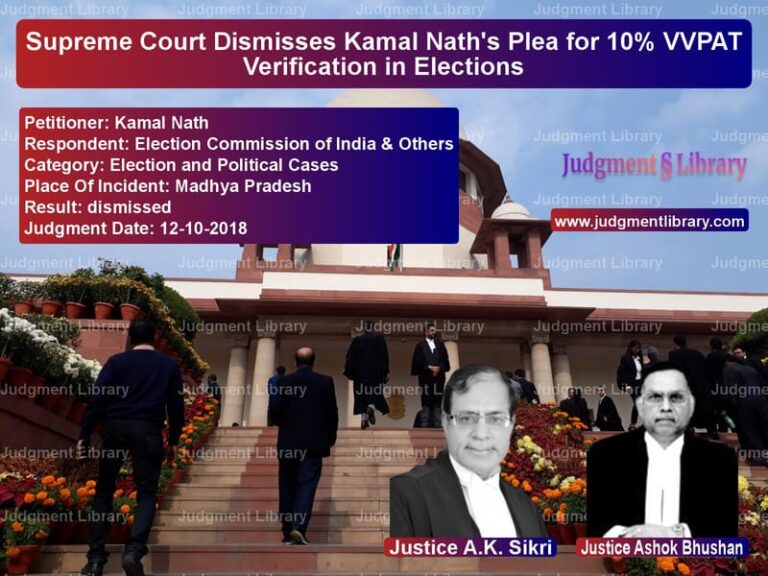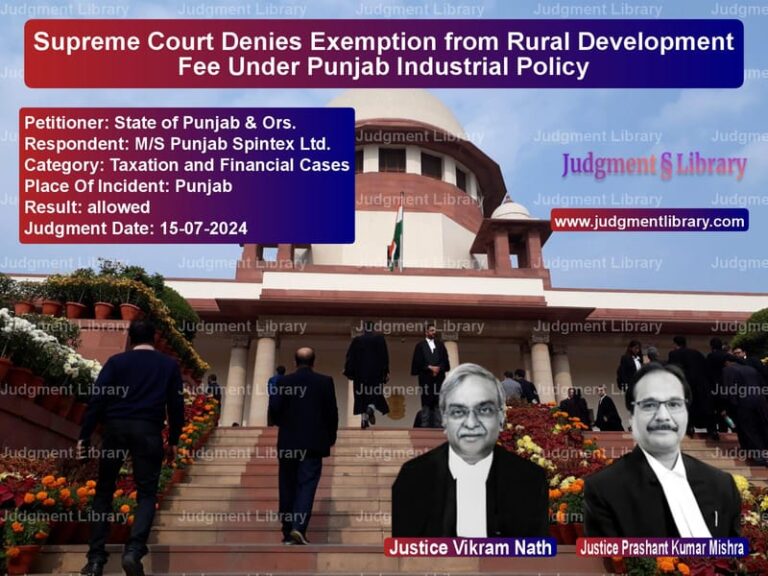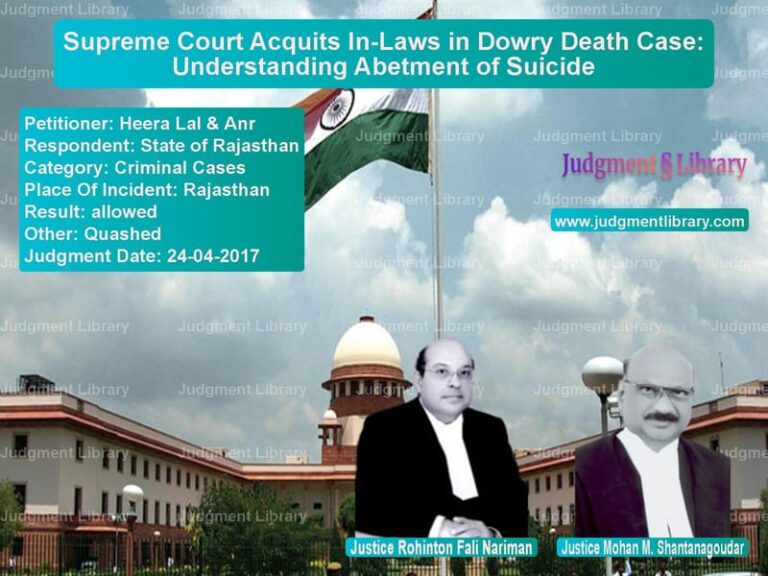Property Boundary Dispute Resolution: Supreme Court Overturns Kerala High Court Remand Order
In a significant ruling that underscores the importance of judicial efficiency in resolving long-pending property disputes, the Supreme Court of India recently delivered a judgment that brings hope to litigants entangled in complex land ownership cases. The case of Peter Augustine versus K.V. Xavier and Others represents a classic example of how property disputes in India can span generations, with legal battles stretching over decades, causing immense financial and emotional strain on all parties involved. This particular dispute, originating from transactions dating back to the 1950s, finally found resolution through the Supreme Court’s intervention, highlighting the court’s commitment to ensuring that justice is not unduly delayed by procedural technicalities.
The roots of this legal battle can be traced back to February 8, 1955, when Peter Augustine’s father executed a sale deed (Sale Deed No.122/1955) for a consideration of Rs. 500, conveying the “Verumpattom Rights” over 9 cents of land in Survey No.1236 in Poomthura Village, Ernakulam, in favor of the father of the respondents. This transaction represented the first formal transfer of rights concerning the disputed property. Nearly a decade later, on February 13, 1964, Augustine’s father executed another important document—a conveyance deed (Conveyance Deed No.185/1964)—for a consideration of Rs. 100, this time transferring the “Jennam Rights” over 9 cents of land in Survey No.1250 in the same Poomthura Village, Ernakulam, again in favor of the father of the respondents. These two transactions, occurring nine years apart, would become the cornerstone of the legal dispute that would emerge decades later.
The complexity of the case deepened in 1993 when several partition and settlement deeds were executed in respect of the subject land in favor of Peter Augustine, thereby devolving the interest of the subject land upon him. This transfer of interest through family arrangements added another layer to the already complicated ownership history. Meanwhile, on March 22, 1994, the father of the respondents executed a settlement deed (Settlement Deed No.1560/1994) in favor of respondent No.1 over the land obtained under both the 1955 sale deed and the 1964 conveyance deed. This settlement deed would later prove crucial in resolving the survey number discrepancy that formed the basis of the legal dispute.
The actual legal battle began when the respondents filed a suit (O.S. No.246 of 2011) before the Principal Sub Court, Ernakulam, seeking declaration of title, fixation of boundary, and injunction vis-à-vis the subject land against Peter Augustine. After examining the evidence and documents presented by both parties, the Trial Court dismissed the suit on October 31, 2017. Unsatisfied with this outcome, the respondents approached the High Court of Kerala at Ernakulam through an appeal (R.F.A. No.42 of 2018). The High Court, in its order dated July 5, 2021, allowed the appeal and remanded the matter back to the Trial Court for reconsideration of evidence. This decision marked the beginning of a series of remands that would prolong the litigation.
Peter Augustine, discontented by the High Court’s order, approached the Supreme Court through a special leave petition (SLP (C) No. 13602 of 2021). The Supreme Court, in its order dated April 10, 2023, granted leave and held that the approach of the High Court in passing the remand order was “totally erroneous since it lacked necessary reasoning.” Consequently, the Supreme Court set aside the High Court’s order and remitted the matter back to the High Court with directions to decide the matter afresh. This intervention demonstrated the Supreme Court’s growing concern about the repeated remands that were delaying the resolution of the dispute.
Despite the Supreme Court’s clear directions, the High Court, through its impugned judgment and final order dated January 9, 2024, once again allowed the appeal filed by the respondents and remanded the suit back to the Trial Court for de-novo disposal. Additionally, the High Court afforded an opportunity to the parties to adduce further evidence. This second remand prompted Peter Augustine to approach the Supreme Court again through the present special leave petition, wherein notice was issued on April 8, 2024, with a direction for the parties to maintain status quo.
During the proceedings before the Supreme Court, Shri Dama Seshadri Naidu, learned Senior Counsel appearing on behalf of the appellant Peter Augustine, presented compelling arguments against the High Court’s decision to remand the case. He submitted that “the learned Single Judge of the High Court has grossly erred in again remitting the matter back to the Trial Court.” He further argued that “the borders and boundaries described in both the sale deed and the conveyance deed would reveal that the property is one and the same.” Elaborating on the necessity of both documents, he submitted that “the conveyance deed was required to be executed after the sale deed to transfer the ‘Jennam Rights’ vested with the father of the appellant to the father of the respondents.” Most significantly, he emphasized that “in any case, the settlement deed is very clear which would show that the property is one and the same i.e., pertaining to survey no.1236 and not survey no.1250.”
On the other side, Shri Manoj V. George, learned counsel appearing for the respondents, defended the High Court’s decision to remand the case. He submitted that “since the earlier report of the Court Commissioner was not clear, the learned Single Judge of the High Court has rightly remitted the matter back to the Trial Court for appointment of another Court Commissioner in order to decide the matter on merits, after getting their reports.” This argument centered on the need for proper identification of the subject land through a Court Commissioner’s report, which the respondents believed was essential for a fair resolution of the dispute.
The Supreme Court, after carefully examining the impugned judgment and the documents on record, made several crucial observations. The bench noted that the High Court had remitted the matter back to the Trial Court primarily on the ground that there had been no proper identification of the subject land by the Court Commissioner. The High Court had observed that unless such identification was made, it could not be said that the subject land was properly identified. However, the Supreme Court paid close attention to the High Court’s own observation that “the boundary description on all the four sides of the property included in Exts. A1, A8, A9 and B6 are one and the same.” The High Court had further noted that “since there is discrepancy in the survey number, and the boundary description on all the four sides in Exts. A1, A8, A9 and B6 being one and the same, an identification based on boundaries would clinch the issue.”
The Supreme Court’s analysis revealed that the sale deed showed the property area as 9 cents with clearly recorded boundaries on all four sides and mentioned survey number 1236. After the appellant’s father acquired “Jennam Rights,” the conveyance deed was executed to transfer these rights to the father of the respondents. Importantly, in this conveyance deed, though the borders, boundaries, and area (9 cents) remained the same, the survey number mentioned was 1250. However, this discrepancy was explicitly clarified in the settlement deed executed by the father of the respondents on March 22, 1994, in favor of Respondent No.1. The Supreme Court particularly emphasized the recital in the settlement deed, which stated: “The birth right of the property which I am giving to you is as per document No.185/64 dated 13.02.1964 and the Survey number is mentioned in the document as 1250 but then as per Sale Deed No.122/55 dated 08.02.1955, as per Thandaper number 276, and Village certificate dated 25.10.1990, the property which I am giving to you is included in Survey No.1236.”
Based on this comprehensive analysis of the documents, the Supreme Court reached a definitive conclusion. The Court stated: “In that view of the matter, we find that the appeal could have been very well decided on the basis of the interpretation of the three documents (being the sale deed, the conveyance deed and the settlement deed) since the area of the property as well as the borders and boundaries shown were the same in all the said documents.” The Court expressed concern about the prolonged litigation, noting that “when the matter could have been decided on the interpretation of the said three documents, again remitting the matter only for the appointment of another Court Commissioner would further delay the proceedings between the parties which have been pending for more than 14 years.”
The Supreme Court also suggested an alternative approach that the High Court could have adopted, observing that “if the learned Single Judge of the High Court was of the view that a Court Commissioner’s report would have assisted in deciding the appeal, the learned Single Judge of the High Court himself could have appointed the Court Commissioner and called for the report.” However, the Court clarified that “even then, in view of the aforesaid discussion, the same was not necessary.”
Ultimately, the Supreme Court concluded that “We are thus of the considered view that the learned Single Judge of the High Court has erred in remitting the matter on the second occasion and as a consequence, the present appeal deserves to be allowed.” The Court allowed the appeal and requested the learned Single Judge of the High Court to decide the appeal on its own merits in accordance with law and in light of the Supreme Court’s observations as expeditiously as possible, within a period of 6 months from the date of the judgment.
This judgment serves as an important precedent in property dispute cases, particularly those involving survey number discrepancies and boundary descriptions. It reinforces the principle that courts should focus on substantive justice rather than procedural technicalities, especially when documentary evidence is clear and unambiguous. The Supreme Court’s intervention in this case highlights its role as a protector of citizens’ rights against unnecessary litigation delays, ensuring that justice is not only done but is seen to be done in a timely manner.
The ruling also emphasizes the importance of properly interpreting historical property documents, particularly in the Indian context where land records often contain discrepancies due to administrative changes, transcription errors, or evolving recording practices over decades. By giving precedence to boundary descriptions over survey numbers when supported by clear documentary evidence, the Supreme Court has provided valuable guidance for resolving similar disputes across the country.
For ordinary citizens engaged in property disputes, this judgment offers hope that higher courts will intervene to prevent endless cycles of remand and reconsideration that often characterize property litigation in India. It sends a clear message to lower courts to exercise their discretion judiciously when ordering remands, particularly in cases where the evidence on record is sufficient for a decision. The Supreme Court’s directive for expeditious disposal within six months further underscores the importance of timely justice in civil disputes, especially those involving valuable property rights.
In conclusion, the Supreme Court’s judgment in Peter Augustine versus K.V. Xavier and Others represents a significant step toward judicial efficiency in property dispute resolution. By overturning the High Court’s remand order and directing prompt disposal of the case, the Court has balanced the need for thorough examination of evidence with the fundamental right to timely justice. This approach is particularly crucial in a country where property disputes often span generations, draining families of their financial resources and emotional well-being. The judgment reaffirms the judiciary’s role as the ultimate arbiter of justice, ensuring that technicalities do not overshadow substantive rights and that long-pending disputes find closure through reasoned and timely adjudication.
Petitioner Name: Peter Augustine.Respondent Name: K.V. Xavier and Others.Judgment By: Justice B.R. Gavai, Justice Augustine George Masih.Place Of Incident: Ernakulam, Kerala.Judgment Date: 23-05-2025.Result: allowed.
Don’t miss out on the full details! Download the complete judgment in PDF format below and gain valuable insights instantly!
Download Judgment: peter-augustine-vs-k.v.-xavier-and-othe-supreme-court-of-india-judgment-dated-23-05-2025.pdf
Directly Download Judgment: Directly download this Judgment
See all petitions in Property Disputes
See all petitions in Contract Disputes
See all petitions in Specific Performance
See all petitions in Damages and Compensation
See all petitions in Judgment by B R Gavai
See all petitions in Judgment by Augustine George Masih
See all petitions in allowed
See all petitions in supreme court of India judgments May 2025
See all petitions in 2025 judgments
See all posts in Civil Cases Category
See all allowed petitions in Civil Cases Category
See all Dismissed petitions in Civil Cases Category
See all partially allowed petitions in Civil Cases Category







